AIR TRAVEL IN JAPAN
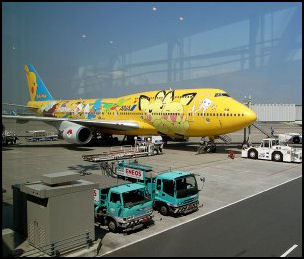
JAL Pokemon 747 Passenger miles: 101 billion (compared 1 billion in Tunisia to 480 billion in the United States). The number of air passengers in Japan increased from 44 million in 1984 to 95 million in 2009.
Regulations on the domestic airline business have been revised, particularly those related to the adjustment of supply and demand. Regulations on double and triple tracks were abolished in April 1997 to encourage competition among airline companies. Also in 1997, new companies were accommodated when increased arrival and departure slots were created by a new runway at Haneda Airport. As a result, two new airline companies, Skymark Airlines and Air Do, were able to begin flights in 1998. Since 2000 airline companies have been able to set fares at their own discretion, and this has led to the introduction of a variety of discount fares plans and an overall reduction in fares. [Source: Web-Japan, Ministry of Foreign Affairs, Japan]
Airports with scheduled flights: 141 (compared to 5 in Tunisia and 834 in the United States). In 2009, a new airport opened in Omitama Ibaraki with no domestic fights and only one international flight, to Seoul. The central government projected that 810,000 people would use the airport but only 77,000 are expected to use it if the Asiana flight to Seoul is at least 75 percent full.
The flying time from New York to Tokyo is about 12½ hours, from Los Angeles about 10 hours. Flights going the other direction are about 1½ hours shorter Many of flights across the Pacific are non-stop. In the old days flights used to stop in Alaska or Hawaii. Many flights from Europe fly over the north pole.
In October 2010, the United States and Japan signed an “open skies” agreement to fully liberalize their civil aviation markets. The accord in principal lets airlines freely decide the number of flights and routes they operate. From the end of World War II until 1951, the Japanese government was deprived of its authority to permit passenger airlines by SCAP (Supreme Commander of the Allied Powers). International and domestic airlines, therefore, didn’t start until 1953.
Singapore Airlines, Air France-KLM and Lufthansa all fly double-deck Airbus A380 superjumbo jets to Tokyo. Lufthansa uses the giant 526-seat Airbus A380 to service its route between Frankfurt and Narita. Daily service began in August 2010.
In August 2010, the Japanese government announced it was considering halving the airline fuel tax, The move could bring some relief to flyers but could also force local airports to close as a result of a lack of funding.
Tukuo Toda of Fukuyama in Hiroshima Prefecture holds the Guinness world record for paper airplane flight. In April 2009, he threw a two-gram plane made of sugar cane paper 18 meters in the air and watched as it slowly circled around a gymnasium, staying aloft for 27.9 seconds — taking 0.3 seconds off the previous record held by an American. Toda became fascinated with paper airplanes while recovering from an injury. He has launched planes from a hot air balloon and the Arc de Triumph in Paris and is currently working with a research company to make a airplane made from heat resistant paper that can be launched from space and land on the Earth’s surface.
National Carriers: Japan Airlines (JAL) JAL ; All Nippon Airways (ANA) ANA ; Small, New Airlines Skymark Skymark site ; Hokkaido International, Air Do Japanese -language site Air Do Air Safety: Air Accidents and Mishaps in Japan Reports on Japan Transport Safety Board mlit.go.jp/jtsb/airrep ; Video of ANA Mishap YouTube ; Airsafe.com Airsafe Air Crashes Record Office baaa-acro.com/ . Aviation Safety Network aviation-safety.net ; Aviation Accidents U.S. Departmen of Transportation ntsb.gov/ntsb/query. ; Air Claims Limited is a London-based aviation consulting firm that provided information on air safety.
AIRPORTS Airport Photos at Japan-Photo Archive japan-photo.de ; Airwise Airport Web Airwise ; TOKYO AIRPORTS Narita AirportOffical Narita Site ; Haneda Airport Haneda Airport Site ; OSAKA, KOBE AND NAGOYA AIRPORTS: Kansai International Airport Kansai official site ; Kobe International Airport Kobe Airport Site ; Chubu Centrair International Airport in Nagoya Chubu Cebtair
Links in this Website: BICYCLES AND MOTORCYCLES IN JAPAN Factsanddetails.com/Japan ; URBAN TRANSPORTATION IN JAPAN Factsanddetails.com/Japan ; TRAINS IN JAPAN Factsanddetails.com/Japan ; SHINKANSEN (JAPANESE BULLET TRAINS) Factsanddetails.com/Japan ; AUTOMOBILES AND DRIVING IN JAPAN Factsanddetails.com/Japan ; AIR TRAVEL AND AIRLINES IN JAPAN Factsanddetails.com/Japan ; SHIPPING AND BOAT TRAVEL IN JAPAN Factsanddetails.com/Japan ; INFRASTRUCTURE AND PUBLIC WORKS IN JAPAN Factsanddetails.com/Japan
Good Websites and Sources on Transportation: Good Photos at Japan-Photo Archive japan-photo.de and japan-photo.de ; Ministry of Land, Infrastructure, Transport and Tourism mlit.go.jp ; Statistical Handbook of Japan Transport Chapter stat.go.jp/english/data/handbook ; 2010 Edition stat.go.jp/english/data/nenkan ; News stat.go.jp
Japanese Planes
Japan has produced one domestically-manufactured airplane, the 64-seat, twin prop YS-11. Designed by engineers who developed the World-War-II fighter the Zero, the YS-11 first went into service in 1962 and was a common sight in the 1970s. A total of 182 planes, including test models, were produced. By the 1980s they were mainly used for carrying cargo. The final flight of a YS-11 in Japan was in Kagoshima in 2006. That year 19 were still being flown outside Japan in Thailand, the Philippines and the United States.
Japan has traditionally used a surprising number of 747s for short-haul domestic flights. They are able to seat more than 550 people because less weight is taken up by fuel. At one time JAL owned 109 747s, more than any other airline. Beginning in the mid 2000s, Japanese airlines began phasing out the 747s and replacing them with smaller, more economical and fuel-efficient planes.
Mitsubishi Heavy Industries and the Japanese government are making plans to produce a 70- to 90-seat passenger jet that ideally will be debut in 2012. The project has a lot of obstacles to overcome. Developing a plan is expensive and competition is tough. About ¥500 million was allocated for the project in 2006. There were plans to up the figure to ¥2 billion in 2007.
Japan allows zero alcohol levels among its airline pilots and cockpit crew. Britain allows a little “bordering on no alcohol.”
Budget Airlines in Japan
Budget airlines in Japan include Skymark, Air Do (Hokkaido International), Skynet Asia and Star Flyer. Skymark flies between Tokyo and Kobe, Fukuoka, Okinawa and two places in Hokkaido. Air Do flies between Tokyo and destinations stops in Hokkaido. Skynet Asia flies between Tokyo and four destinations in Kyushu. Star Flyer flies between Tokyo and Osaka and Fukuoka.
Skymark was established by the Japanese travel company HIS in 1996. When it began operating between Tokyo and Fukuoka it boasted tickets half the price as those offered by established airlines. It offered cheap tickets by adopting cost cutting measures such as no in-flight magazines or newspapers.
Skymark has had problems with a shortage of pilots and had to cancel flights. It has tried to stay afloat by doing its own maintenance and crew training and shedding unprofitable routes. In 2008 it introduced a new pricing system in which tickets prices varied according to how full the plane was.
Skymark has been reprimanded for flight and maintenance problems. In December 2005, one of its plane made an emergency landing because of an engine fire. Skymark has been doing well recently. Its cheap prices attract both tourists and business travelers.
In 2010 Skymark was told by the Japanese Transport Ministry to improve its safety after 1) photos were revealed that showed a pilot and other crew members posing for photographs in a plane’s cockpit during a flights; 2) cabin attendants did not answer intercom calls because of their inadequate English-language skills; and Skymark planes flew at altitudes different from those instructed by air traffic controllers.
Skymark has plans to use superjumbo jets on international routes. In February 2011, Skymark ordered four double-deck Airbus A380 superjumbo jets with plans to use them to connect Tokyo with London, Paris and Frankfurt.
Air Do started operating in 1998. It filed for protection in 2002. Skynet Asia started service in 2002. It also was having trouble in 2004. Both airlines have asked ANA for help and now both have code sharing agreements with ANA.
Budget airlines were made possible by airfare deregulation starting in the early 1990s. In 1996 a new airfare system pricing system went into affect that allowed airlines to set their own air fares.
Competition is very stiff in the budget airlines company ANA for example offers flight at just slightly more than Skymark flights with flights at roughly the same time.
Air Routes in Japan
The Tokyo-Sapporo route is the world busiest, flying 7.6 million passengers a year. It is also one of the most expensive. A standard round trip ticket for the 80 minute flight costs $400. During the off season you can fly between Tokyo and Los Angeles for the same price.
The world's longest nonstop scheduled flight in terms of time (15 hours, 10 minutes) is between Osaka and Istanbul on Turkish Airlines. The world's longest nonstop scheduled flight in terms of distance (7,968 miles) is between New York and Johannesburg on South African Airlines. [Source: Guinness Book of Records]
High fuel prices have forced airline companies to cut back on domestic routes. In July 2008, the cost of Singapore kerosene, a popular jet fuel in Asia, reached $165 over barrel, almost double what it was a year earlier.
Airports in Japan
Japan has 98 airports. Many of them are little used in part because Japan has such a great train system. See Airports, Travel Infomation
In March 2010, the new Ibaraki airport opened. With only one regularly scheduled flight, Ibaraki is the third airport on the Tokyo area but is located inconveniently far away. In 1999, the central government projected that 810,000 people would use the airport. As this point it looks as if it will be lucky to get 50,000. Excessively high projections for usage at airports has neem a problem a number of airports.
Some have suggested putting a massive airport in Tokyo Bay. One planner told AP, "In Japan, there's no land. Airports in the sea are the only choice.”
It costs about $10,000 to land a 747 at Narita, 10 times the landing fee at Heathrow Airport outside London. Airlines had little choice but to pay it of they wanted access to the lucrative Japanese market. Landing at Kansai is even more expensive.
Narita is scheduled to be privatized soon.
A Japanese man Hiroshi Nohara won some notoriety after spending four months living Terminal 1 of the international airport in Mexico City, somewhat like the character in 2004 Steven Spielberg movie “The Terminal”. The only difference was that Nohara had a valid visa and a ticket home.
Narita Airport
Narita Airport (Offical Narita Site , about 40 miles from downtown Tokyo) is officially named the New Tokyo International Airport. As of 2007, Narita accommodated 35.48 million passengers on 1,552 flights a week from 94 cities in 40 countries. About half of the international flights in and out of Japan before the second runway was built. This figure may increase to 77 percent when the second runway is fully utilized. Since its opening in 1978, Narita Airport has been the embarkation point for many overseas passengers. The number of the airport’s flights is set to increase after the extension of a runway in 2010. And the airport is more convenient than ever now that the new Sky Access train makes it possible to travel from Narita to the center of Tokyo in just 36 minutes.
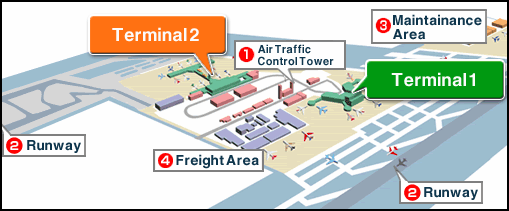
Narita map
Even though the Tokyo metropolitan area is the most populous urban area in the world until recently it was served by one international airport, which until recently had only one runway that closed at 11:00pm every night because of noise restrictions. By contrast, other large cities such as London, Paris and New York are served by two, three or four airports, all with multiple runways often open 24 hours a day. Construction of Narita and plans to expand have been delayed for decades due to objections by local farmers, supported by leftists. Confrontation and violet protests over the airport led to six deaths, 15 suicides and the ransacking of control towers
A second runway at Narita finally opened in April 2002 on the eve of the World Cup soccer tournament. Due to the inability of the airport to make a deal with two local farmers the second runway is only 2,180 meters long (much shorter than the originally planned 2,500 meters) and is too short to accommodate 747s but can handle Boeing 767s and Airbus A300s. Planes land just 125 feet over one farmhouse and have to detour out of their way to get around another farmhouse on their way to the terminal.
The second runway was made possible when a single farmers sold his land in 1999. It is hoped the runway could be extended to the south in future when a deal is worked out with farmers blocking the project. But these farmers have said they will never sell their land. In the mean taxiways bend around land still held by farmers, sometimes causing delays because planes can’t land or take off when another plane in on the taxiway.
Work began to extend the new second runway at Narita to 2,500 meters long—so long it can accommodate jumbo jets — was completed in October 2009. The runway was extended north instead of south as was originally planned because the two farmers in the south continue to refuse to sell the few hectares of land needed to fulfill the original plan. The new plan will take six years and ¥33 billion to complete, twice the cost and time needed to build the extension south.
Narita’s Runway A is expected to become fully operational in 2012 despite the presence of a “utility shed” — the foundations of 62-meter tower set up in 1972 by opponents of the airport to block landings and take-offs — 750 meters from end of the runway that had prevent instillation of land lights. The tower was removed in 1977 but the fountain that remained kept landing lights from being installed. In 2010 the Japanese government changed the rules on the landing lights based on improvements made in plane performance that make the landing lights less necessary.
To better compete with Haneda, Narita is planning a big expansion that will involve the construction of a new terminal for low-coast carriers. Even with competition from Haneda, some expect the number of takeoff and landing slots to rise from 220,000 a year in 2010 to 300,000 in 2014. In the summer of 2010, Narita began offering free Internet access.
Haneda Airport

Haneda Airport (Haneda Airport Site about seven miles from downtown Tokyo) in Tokyo is Asia’s busiest airport. Primarily a domestic airport for Tokyo, Haneda counted 67 million passenger arrivals and departures in 2007, making the world’s forth busiest airport behind Atlanta’s Hatfield-Jackson Chicago O’hare and London Heathrow. The vast majority of the flights are domestic flights. Haneda handles 303,000 take offs and landings a year. That figure is expected to rise to 447,000 a year in 2013. About 170,000 people use Haneda Airport daily. During peak hours, 50,000 visitors and workers are at the airport, while about 100 airplanes are on runways and aprons.
“Tokyo International Airport, commonly referred to as Haneda Airport, opened in 1931 as Japan’s first commercial airport. It served as both as a domestic and an international airport until 1978, when the New Tokyo International Airport opened in Narita. From that time Haneda Airport was mainly used for domestic flights, but in 2010, after a fourth runway came into use, it began offering a variety of flights to foreign destinations as well, including not only Asian cities such as Seoul, Shanghai, and Hong Kong, but also major cities in Europe and the United States such as Los Angeles, New York, and Paris. [Source: Web-Japan, Ministry of Foreign Affairs, Japan]
The new international terminal and runway at Haneda opened in October 2010. Japan Airlines, ANA, Delta, British Airways and American Airlines offer service to several foreign destinations, including Paris, New York, Los Angeles, Detroit, London, Bangkok, Beijing , Seoul, Hong Kong, Singapore and Honolulu. Haneda will handle 60,000 international flights a year, 30,000 during the daytime and the rest from late night to early morning. Flights from Haneda to the U.S. and Europe will be limited to late at night and early morning when flights at Narita are not available. In 2013 an additional 30,000 flights will be added. Five U.S. Airlines have applied for Haneda slots — Delta, American, United, Continental and Hawaiian Airlines.
Haneda now has four runways, which are arranged sort of like a rectangle whose sides have come unhinged. Runway D — much of which sits on 1,165 stainless-steel-plated iron pillars sunk into the Tamagawa River — opened in October 2010 after construction began in 2007. It is 3,120 meter long. Runways A and C parallel each but the northern end Runway A intersects the middle of Runway B at an angle. Runway D — not quite parallel to Runway B — is situated on a new piece of reclaimed land. During the evening rush hour, which begins about 6:00pm air traffic controller have their hands full dealing with 59 planes taking off and landing every 50 minutes. To monitor everything a new 115.7-meter-tall air traffic control tower was built.
Haneda has a bit of a bird problem. It experiences more bird strikes than any other airport in Japan. The airport has round-the-clock bird patrols that use blank shots and fireworks to scare away birds. Even with patrols operating from 5:30am to 7:30pm in 2008, there were 135 bird strikes, more than double the 62 at Osaka’s Itami airport. Authorities plan to install anti-bird strike radar in the near future.
The new government that came to power in 2009 has suggested opening up Haneda to more international flights, and turning it into a major international hub for East Asia along the lines of Inchon Airport in South Korea and the Hong Kong Airport. There is a lot of resistance to this idea from the folks at Narita Airport.
OSAKA, KOBE AND NAGOYA AIRPORTS
“Osaka International Airport is also called Itami Airport. It handled most domestic and all international flights to the Kansai region until the opening of Kansai International Airport in September 1994. It is now used mainly for domestic flights.
Kansai and Osaka (Itami) airports formed an alliance in 2010 to cooperate and organize their air routes so they complement each other rather than compete. Kansai Airport has cut is fees and has began to attract budget international airlines such as Air Busan, Star Flyer and Jeju Air, which flies to South Korea, Jet Airways which flies Australia, Cebu Pacific Air, which flies to the Philippines
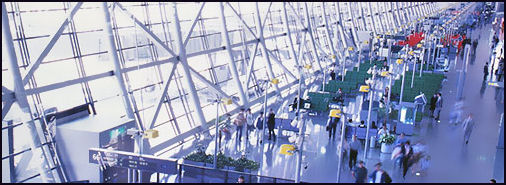
The second runway has been infested with locusts. There were worries that large insects could be present a potential hazard for aircraft landing or taking off. A major eradication effort was launched to get rid of them before the runway opened, A similar problems occurred when the first runway opened and it was temporarily closed because of airlines complaining about insects getting sucked into engines and splattering on the cockpit windshields.
Kobe International Airport (Kobe Airport Site) opened in Kobe in February 2006, bringing the total of airports in the Osaka area to three. Like Kansai Airport, it is built on reclaimed island in Osaka Bay. It has a 2,500-meter-long single runway capable of handling jumbo jets and is connected to the mainland by bridge. Service began with 54 daily flights to seven destinations in Japan by JAL, ANA and Skymark Airlines. The airport cost more than $2 billion and left Lobe city deeply in debt,
Kobe Airport was built for $3 billion on a 272-hectare artificial island and was used by 2.74 million passengers the highest number if any municipal airport in Japan. After Kobe Airport opened there were a number of incidents involving planes colliding with birds. Many reclaimed plots near the airport have yet to be sold and have become nesting areas for sea birds such as little terns which have been involved in most of the bird strikes.
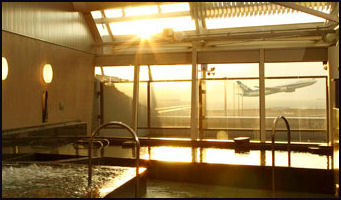
watch the planes take off
while taking a bath Chubu Centrair International Airport (Chubu Cebtair) opened outside Nagoya in February 2005. It is built on a manmade island off Tokoname in Aichi Prefecture and aims to be an international hub and the third major airport in Japan after Narita and Kansai. It opened with 293 international flights, including cargo flights, and 94 domestic flights. It is located far enough from major residential areas that it can operate 24 hours a day.
“Chubu Centrair International Airport is the principal airport for the city of Nagoya. The airport is designed to be easily accessible by everyone, regardless of age or physical disability, incorporating universal design elements such as a design that allows travelers to proceed from the train platform to the arrival or departure lobby without changing floors. Chubu Airport has duty-free shops, shopping arcades, a wide choice of restaurants and even a garden with a wedding venue and baths where one can watch planes land and take off. The airport was very popular with Nagoya residents who visited it as a tourist attraction and a place to enjoy a meal.
Kansai Airport
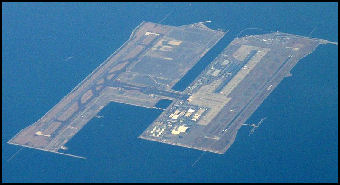
Kansai International Airport (Kansai official site 15 miles outside downtown Osaka) is the world's most expensive airport and one of the most ultra-modern ones. Built three miles offshore in Osaka Bay on a 1,250 acre artificial island at a cost $14 billion, it opened in 1994 as was declared one of the greatest engineering achievements of the 20th century by the American Society of Civil Engineers along with the Empire State Building, Panama Canal and Golden Gate Bridge.
In addition to providing expanded service and access by a greater number of international carriers, Kansai International Airport is Japan’s first 24-hour facility. The number of landings and departures totaled 106,873 in 2010. The airport is equipped with state-of-the-art technology, including a system to automatically turn off air conditioning when travelers are not in the building, as well as a “jack-up system” that gauges the settlement of the building and then makes height adjustments to prevent unequal settlement.
The artificial island was created by sand mined from sites in the airport area and carried to the site by special hopper barges that dump the sand on the sea bed or feed it to barges that dump it on the island or into dump trucks the spread the sand around, Eight large sand piling barges — designed for deep sea operation — drove 1.2 million tons of sand into the sea floor before the island was produced to improve drainage and firm up the sea floor about 20 meters below the surface
The mile-long arched terminal at Kansai Airport was designed by the famed Italian architect Renzo Piano. It features huge drapes on the ceiling that direct air though the airport, a large multi-level shopping area, glass elevators and suspended walkways. Across from the terminal is hotel. A 3,750-meter-long double decker bridge connects the Osaka with the airport. The upper level is for vehicles and the lower level is for electric trains.
The airport sinks at a rate of one millimeter ever day; keeping it level is a web-like network of enormous hydraulic jacks. Between 1987, when construction began, and 2001 the ground beneath the airport had subsided 38 feet and is expected to sink another three feet before it stabilizes. As of 2001, the airport operator had spent $2.21 billion on repairs, including a concrete wall in the terminal's basement to prevent seawater seepage. To pay for all this the airport charge some of the world’s highest landing fees and departure taxes ($22).
As of 2007, Kansai accommodated 16.61 million passengers on 765 flights a week from 66 cities in 27 countries. Even though Kansai handled about 20.5 million passenger a year at its peak. This is far less than expected. As a result of this and debts accrued from construction and repair had cost the airport about a $1 billion a year. Kansai airport turned a profit for the first time in 2004 but only managed that with government subsidies.
The new 4000-meter-long second runway — the longest in Japan and considerably longer than Kansai’s first 2,500-meter-long runway — opened at Kansai in 2007. Built on a new reclaimed area about the size of the first, it has been criticized for being too expensive and too far away from the terminal. Requiring planes to taxi for six kilometers and 10 minutes to reach the terminal. Construction of the second terminal to go with the new runway has been delayed.
Kansai is known in some circles as the world’s most expensive airport.Landing fees at Kansai are the world’s highest, and 50 percent higher than those at Narita. Some airlines — including American, United and Air Canada — have discontinued routes to Kansai. To make up for a lack of passengers Kansai is trying to market itself as cargo delivery hub and attract more planes from Asia, particularly China. To get more airlines to come Kansai has cut its landing fees by 80 percent from ¥580,000 to around ¥100,000, compared to ¥170,000 at South Korea’s Inchon Airport. In 2009 the Japanese government decided to cut grants to Kansai Airport. The mayor of Osaka responded by suggesting one solution to the controversy over where to locate an American military base was to put it at Kansai airport.
Image Sources: 1) Ray Kinnane 2) Doug Mann Photomann
Text Sources: New York Times, Washington Post, Los Angeles Times, Daily Yomiuri, Times of London, Japan National Tourist Organization (JNTO), National Geographic, The New Yorker, Time, Newsweek, Reuters, AP, Lonely Planet Guides, Compton’s Encyclopedia and various books and other publications.
Last updated July 2012
